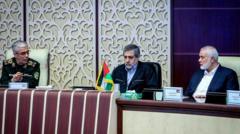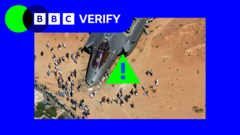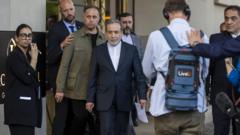President Trump confirmed successful airstrikes targeting three major Iranian nuclear sites, including Fordo, igniting fears of a broader conflict in the Middle East. With Iran threatening retaliation and regional stability at risk, the situation is rapidly evolving.
Escalation in US-Iran Tensions: A Closer Look at Military Strikes on Nuclear Facilities

Escalation in US-Iran Tensions: A Closer Look at Military Strikes on Nuclear Facilities
Recent US military strikes on Iranian nuclear sites have heightened tensions between the nations, prompting discussions on potential retaliation and the implications for regional stability.
In an unprecedented move, US President Donald Trump has announced that American forces have successfully conducted airstrikes on three nuclear facilities in Iran, significantly escalating tensions in the already volatile region. The targets included key sites at Fordo, Natanz, and Esfahan, with Trump claiming, "All planes are now outside of Iran airspace," after achieving the objective of neutralizing these crucial components of Iran’s nuclear program.
The strikes were executed in what Israeli officials described as "full coordination" with the US military, following a surprise attack carried out by Israel on June 13 that aimed to dismantle Iran’s nuclear capabilities amid ongoing hostilities. The Iranian government maintains that its nuclear pursuits are for peaceful purposes, yet after this latest strike, military retaliation against US assets in the region has become a significant concern.
Details of the operation reveal that the US employed Massive Ordnance Penetrators (MOPs), designed to penetrate substantial underground fortifications like Fordo, which is notoriously built deep within a mountainside, making traditional strikes virtually ineffective. The use of these munitions signifies a serious commitment to targeting Iran's nuclear ambitions, raising questions about the potential success and consequences of such aggressive measures.
Initial assessments of the damage caused by the airstrikes remain unclear, though Iranian state media suggests that the facilities were largely evacuated prior to the attacks, mitigating possible impact. Nevertheless, the death toll from the continued conflict with Israel has escalated, exceeding 200 casualties, with thousands more injured as retaliatory actions ensue.
In a display of heightened alertness, Israel is responding to the strikes by tightening security measures nationwide, including restrictions on public gatherings and educational activities. Meanwhile, Iranian officials have warned of disastrous consequences for any US involvement, threatening to retaliate against American military bases scattered throughout the Middle East, particularly targeting critical strategic sites such as the US Navy's 5th Fleet HQ in Bahrain.
As both nations brace for potential escalation, questions arise regarding the legality of Trump's military actions without congressional approval. While he has powers as Commander in Chief, calls from lawmakers to limit his capacity to order strikes suggest a growing division on military policy towards Iran, with some initiatives likely to take weeks before formal votes in Congress.
With the potential for an all-out conflict looming, observers worldwide are closely monitoring the situation, assessing how the developments will alter dynamics in the region and impact global security as events unfold.
The strikes were executed in what Israeli officials described as "full coordination" with the US military, following a surprise attack carried out by Israel on June 13 that aimed to dismantle Iran’s nuclear capabilities amid ongoing hostilities. The Iranian government maintains that its nuclear pursuits are for peaceful purposes, yet after this latest strike, military retaliation against US assets in the region has become a significant concern.
Details of the operation reveal that the US employed Massive Ordnance Penetrators (MOPs), designed to penetrate substantial underground fortifications like Fordo, which is notoriously built deep within a mountainside, making traditional strikes virtually ineffective. The use of these munitions signifies a serious commitment to targeting Iran's nuclear ambitions, raising questions about the potential success and consequences of such aggressive measures.
Initial assessments of the damage caused by the airstrikes remain unclear, though Iranian state media suggests that the facilities were largely evacuated prior to the attacks, mitigating possible impact. Nevertheless, the death toll from the continued conflict with Israel has escalated, exceeding 200 casualties, with thousands more injured as retaliatory actions ensue.
In a display of heightened alertness, Israel is responding to the strikes by tightening security measures nationwide, including restrictions on public gatherings and educational activities. Meanwhile, Iranian officials have warned of disastrous consequences for any US involvement, threatening to retaliate against American military bases scattered throughout the Middle East, particularly targeting critical strategic sites such as the US Navy's 5th Fleet HQ in Bahrain.
As both nations brace for potential escalation, questions arise regarding the legality of Trump's military actions without congressional approval. While he has powers as Commander in Chief, calls from lawmakers to limit his capacity to order strikes suggest a growing division on military policy towards Iran, with some initiatives likely to take weeks before formal votes in Congress.
With the potential for an all-out conflict looming, observers worldwide are closely monitoring the situation, assessing how the developments will alter dynamics in the region and impact global security as events unfold.






















